Everyone can agree that braking is as important as acceleration. If you fixate on performance mods and ignore braking and handling, your car won’t be able to handle all that extra power.
Good brakes can actually make you faster. They allow you to brake later and harder before you turn into a corner. The split seconds that you save in the process can do wonders for your lap times.
But before you spring for a big brake kit or upgrade your stock brakes in any way, understanding the difference between floating and fixed calipers will help you make an informed decision.
These are the two main types of calipers that you’ll come across. One isn’t objectively better than the other. What’s right for you will depend on your specific use case.
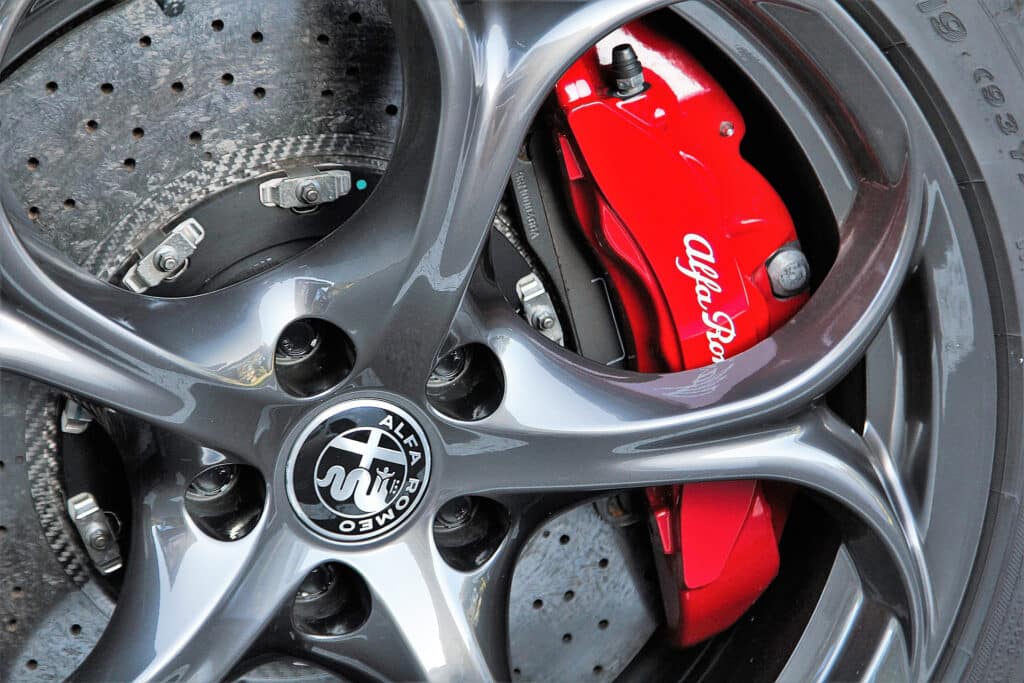
It’s worth noting that there’s a lot more to stopping effectively than just calipers. Different types of brake pads, tires, rotors, and even brake fluid will affect braking performance.
In this article, we’ll compare floating and fixed brake calipers, explain how they work, and discuss the pros and cons of each.
Understanding Brake Calipers
Before we get into the details of what makes floating and fixed calipers different, let’s take a quick look at what brake calipers do exactly.
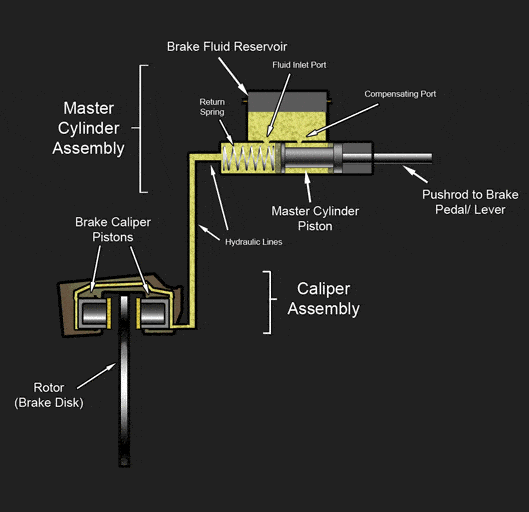
The main purpose of a brake caliper is to clamp a spinning rotor between two brake pads in order to slow it down. It does this with the help of a piston that’s operated via pressurized hydraulic fluid.
We won’t deep dive into how hydraulic brakes work, but if the subject of fluid mechanics interests you, check out Pascal’s Law — that’s the principle upon which this technology is based.
“Pressure exerted anywhere in a contained incompressible fluid is distributed equally in all directions throughout the fluid.”
Pascal’s Law
When you hit the brake pedal, a plunger depresses in the master cylinder and all four calipers receive pressurized fluid at the same time.
The fluid then pushes the piston which results in a small but powerful mechanical movement. It is this movement that pushes the carrier plates and squeezes the brake pads as a result.

And that’s where the key difference between floating and fixed calipers lies — the mechanical movement that clamps the brake pads together is carried out differently in both types of calipers.
How Does a Floating Caliper Work?
Floating calipers exert a clamping force on brake rotors by means of one single-sided piston. Dual-piston floating calipers do exist, but what’s important is that both pistons are located on the same side of the caliper.
If the piston is only on one side of the caliper, it’s fair to question how the brake pads operate on both sides.

When you depress the brake pedal, the master cylinder sends pressurized fluid to the piston. It then pushes the inboard brake pad against the rotor.
Once the brake pad makes contact with the motor, the piston’s movement is restricted. However, you’re still pressing the brake pedal, so you’re still exerting force on the caliper.
The next component that has any kind of flex is the outer side of the caliper. And the reason why it has any flex is that it’s connected to the inner side of the caliper by means of sliding pins.
As a result, the opposing side of the caliper slides inward to make contact with the outboard brake pad, effectively completing the clamping motion.

Most modern cars that you see today have floating or semi floating calipers. Fixed calipers are commonly seen on higher-end sports cars, and you’ll see why that’s the case in the next section.
What is a Fixed Brake Caliper?
As the name suggests, fixed calipers don’t have any moving parts other than the pistons and brake pads. They’re a solid monoblock unit.
The key difference between these and floating calipers is the absence of slider pins. Unlike floating calipers that have pistons only on one side, fixed calipers have pistons on both sides.
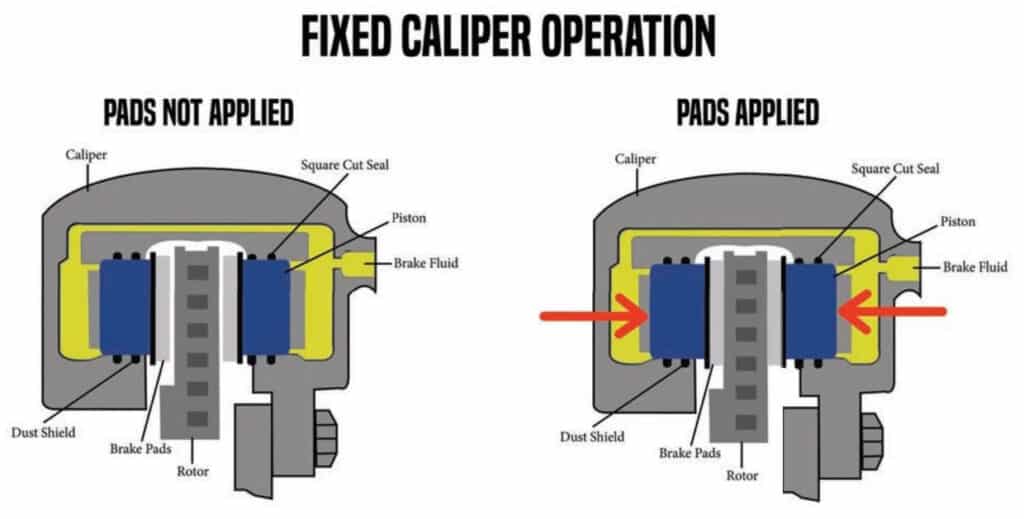
You’re probably wondering how the opposing pistons push the outer brake pad if there’s no sliding mechanism in place.
The opposing or outboard pistons are supplied with the same pressurized hydraulic fluid as the inboard pistons via one or multiple channels.
This results in equally distributed clamping force and braking power as a result.
Floating vs Fixed Calipers: Pros and Cons
Both floating and fixed calipers do an excellent job at slowing your car down. As we mentioned earlier, one isn’t objectively better than the other because what’s right for you depends on your driving style and requirements.
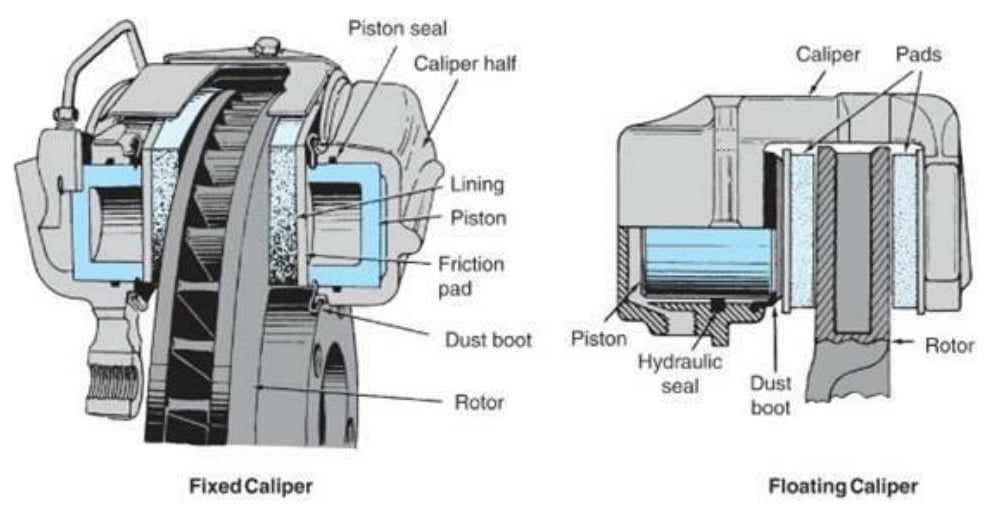
And besides, braking performance depends on factors such as the effectiveness of the master cylinder, caliper clamping pressure, brake pad material, tires, car weight, and suspension geometry to name a few.
Most importantly, if all other variables are considered equal, it is the area of the pistons that affects the stopping power the most. This is something you can calculate for the purposes of comparing two different brake units.
Below we’ve listed some of the pros and cons of both fixed and floating calipers.
Fixed Caliper Advantages
Even though floating calipers are the industry standard, you can always go in for an upgrade and install fixed calipers.
The most notable advantage with these is equal distribution of clamping force between the inward and outward pistons which results in better braking performance overall.
This is ideal if you frequent the track or if your car is faster than what it was intended to be.
Increased stiffness is another advantage. Because of how rigidly fixed calipers are secured, they offer consistent braking performance and pedal feel.
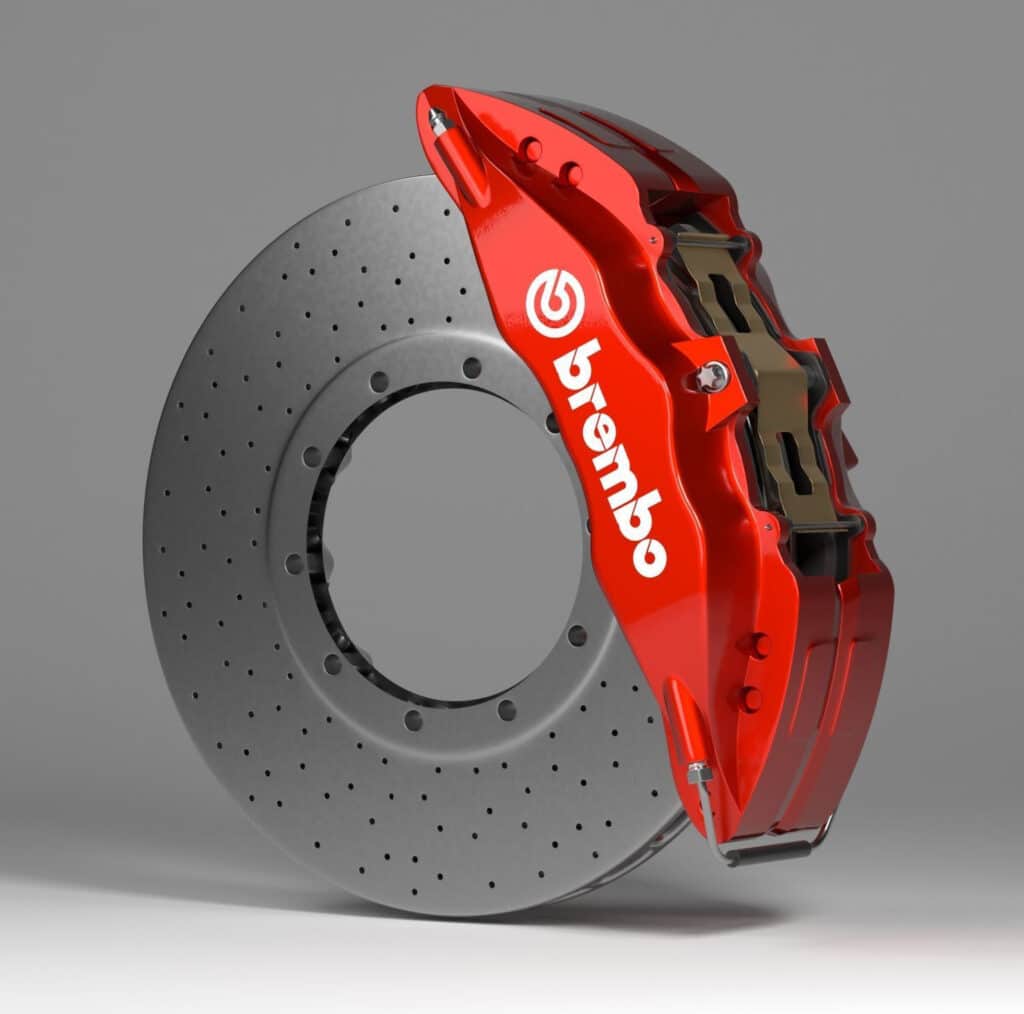
Moreover, the brake fluid generally doesn’t get as hot with fixed calipers, which means brake fade won’t occur as quickly as it would with overworked floating calipers. Plus the pad wear remains nice and even.
Fixed calipers are fairly lightweight because they’re constructed from aluminum alloy. This makes for a slight reduction in unsprung weight which is always a good thing.
Not only does the aluminum construction allow for a lightweight design, but it also dissipates heat really well and it doesn’t rust or corrode.
These calipers also have a longer service life owing to fewer moving components. They need less maintenance in comparison to floating calipers.
Another cool thing about fixed calipers is that they’re self-adjusting. Because there’s no sliding mechanism, as the brake pads start to wear down, the pistons adjust automatically and fill in the void left by worn-out friction material.
Changing the pads out is extremely simple and requires no disassembly.
Disadvantages of Fixed Calipers
Fixed calipers have many advantages, but there’s a reason why most cars use floating calipers. The primary reason for this is that fixed calipers are more expensive to manufacture.
Most economy cars stop just fine with floating calipers, so there’s no incentive for manufacturers to spend the extra money on fixed calipers.
As a result, fixed calipers are almost always seen in high-performance and luxury cars.

Even though fixed calipers have fewer moving parts in comparison with floaters, they have a more complex design and intricate internal components. This makes them more susceptible to leaks, although it’s a rare occurrence.
Piston knockback is another known issue with fixed calipers. Misaligned wheel bearings or warped rotors can cause the brake pads to be pushed further away from their original position.
As a result, the pistons get knocked back further into their bores. This results in a spongy brake pedal and an unusually long pedal stroke before the brakes finally bite.
Drivers typically remedy this by dabbing the brake pedal a few times before they actually intend on slowing down, which is not ideal.
Even though fixed calipers are lighter than floating calipers, they are a lot larger for the purpose of adding more surface area.
This leads to compatibility issues on many cars, requiring you to install new rims to accommodate the larger calipers.
Advantages of Floating Calipers
Floating calipers are tried and tested. They provide ample braking performance for most applications, and they’re seen on most modern cars today.
They’re a lot cheaper to manufacture in comparison with fixed calipers. That’s because they’re a lot simpler in design and have fewer components, considering how the piston is single-sided.
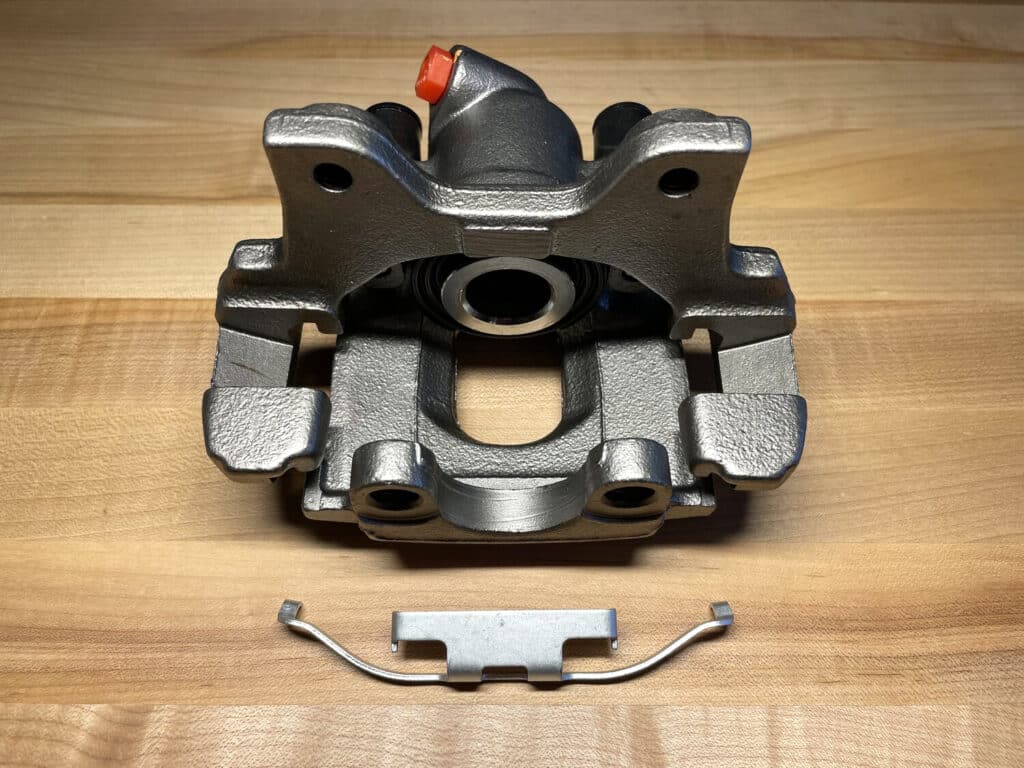
Floaters don’t have complex internal oil channels because there’s no opposing piston. Instead, they use simple mechanical slider pins. They do need frequent maintenance, however.
Another advantage of only having one piston is that possibility of leaks is lower. This also makes it easier to bleed the brakes and perform other types of maintenance.
Because of how compact floating calipers are, they won’t limit your rim selection, and you won’t have to worry about running into clearance issues when buying new wheels or suspension components.
Disadvantages of Floating Calipers
While floating calipers are by far the more common option in vehicles, that doesn’t mean they’re automatically better than fixed calipers.
Floaters have moving parts, most notably the slider pins. These pins have a very important function which is to clamp the opposing side of the rotor with the outboard brake pads.
If these aren’t lubricated and well maintained, it can lead to loss of braking power and uneven pad wear.
Over time, as the caliper ages, dirt, grime, and corrosion can cause the moving components in a caliper to stick. Fixed calipers don’t have this problem.

Floating calipers also create an increased potential for pad dragging. And because they typically have larger pistons and aren’t able to split the load equally on both banks of the caliper, they tend to heat up the brake fluid more than fixed calipers.
Lastly, these calipers typically weigh a lot more than fixed ones because they’re constructed using cast iron or steel.
When Do You Want Floating or Fixed Calipers?
Now that you know more about floating vs fixed calipers you can make a more informed decision as to which one is the right choice for your car.
If you take your car to the track often, or if you enjoy spirited driving and need more braking performance, then fixed calipers are ideal.
But if you simply want to replace your OEM caliper with something newer with the intention of restoring lost braking power, then floating calipers are the way to go.
In fact, many sports cars use floaters. The Mazda RX8 for instance comes with single piston, cast iron, floating calipers.
It’s really only if you’re driving in much more extreme conditions that you’ll really need the extra braking force that fixed calipers provide.
Of course, there’s nothing wrong with wanting a little more powerful brakes even if you don’t absolutely need them.
Concluding Thoughts
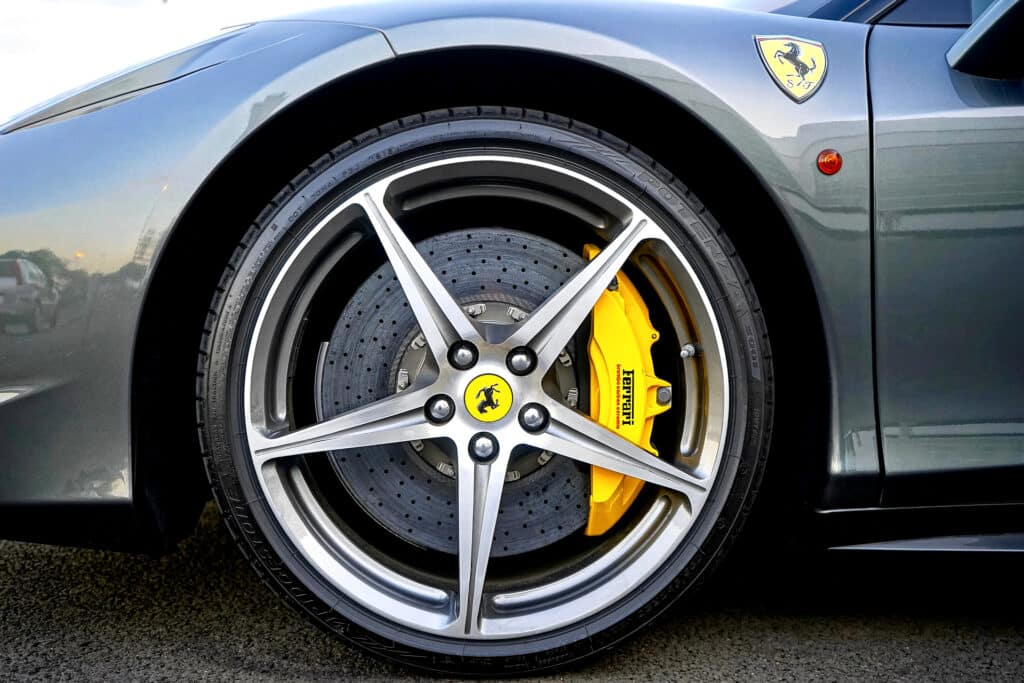
Whether you have floating or fixed calipers on your car, what’s important is that you maintain your braking system well.
Timely brake fluid replacement, checking pad wear regularly, and just ensuring that your brakes are working properly is extremely important even if you aren’t racing.
If you intend on changing out your brakes, wheels, or suspension, it will help to club your product selection to ensure you don’t run into compatibility issues.
What’s your first choice when it comes to braking systems? Would you rather choose floating calipers over fixed ones? Let us know by leaving a comment below!
And if you’ve enjoyed reading this article, do share it with your friends and post it on Reddit, Facebook, or your favorite online forums. We appreciate your support!


1 comment
Another minor thing: floating calipers are slightly easier to change the brakes on. You don’t have to remove the whole caliper from the wheel hub to change the pads, you can just remove one slide pin and then lift up the floating section, whereas fixed calipers require removal.